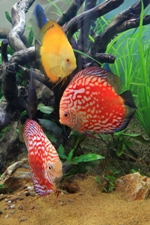While fish welfare may not be a core skill for most removals companies, being able to offer a little guidance to your customers on how to tackle the job might occasionally come in handy.
Moving customers’ furniture and personal possessions is tricky enough, but when they include a tank full of tropical fish things can get even trickier. While fish welfare may not be a core skill for most removals companies, being able to offer a little guidance to your customers on how to tackle the job might occasionally come in handy. The Mover called on leading aquatics specialists Rolf C. Hagen for some helpful advice on how to make sure everything goes swimmingly and that the fish arrive in their new home without a scale out of place - this is what they said.
First you’ll need to get together some water containers large enough to hold about half the water in the aquarium; some fish bags for the fish to swim around in during their journey, and some polystyrene fish boxes to insulate the bags from the cold. All these are available from your local pet shop or aquatic dealer.
Fill the bags one-third full with water from the aquarium; it’s important to maintain the fishes’ established environment. Don’t fill them to the top as this will suffocate the fish. Carefully transfer the fish to the bags using a fine mesh net, be sure not to put too many fish in each bag; no more than five to ten small fish, or one to three large ones in each, that’s based on an average size bag of twenty inches by eight. Add 2 or 3 drops of water conditioner like Nutrafin Aqua Plus to each bag to help the fish cope with the stress and seal the bags, trapping as much air as possible. It’s best to avoid feeding the fish for two to three days before transporting them; this will reduce the level of waste contamination in the water and keep the fish healthy.
If you’re moving tropical fish wrap the fish bags in newspaper before placing them in the fish box and put a hot-water bottle in there to keep them warm. Don’t use boiling water; hot water from the tap will be fine and wrap the bottle in a towel.
Now it’s time to remove the substrate from the bottom of the tank and rinse it using the remaining water from the aquarium – note that tap water should not be used. It should then be placed in a suitable container for transportation. The filter media should be left wet; don’t be tempted to rinse it under the tap as this will destroy the beneficial bacteria that has built up.
This is a good time to consider upgrading your aquarium to a larger size. Having put yourself and your fish through so much inconvenience it would be a pity to go through it all again after you’ve moved in. A word of caution, it’s important never to downsize the aquarium if the same number of fish are going to occupy it, and if you’re thinking of increasing your stock you’ll definitely need a bigger tank.
When the aquarium is in its new location add the substrate and the original water, topping up with luke warm tap water; ideally the overall water temperature should be between 22 and 25 degrees centigrade for tropical fish, room temperature for cold water species. Before adding to the aquarium, tap water should always be treated with a water conditioner, such as Nutrafin Aqua Plus, to remove chlorine, chloramines and heavy metals that are harmful to fish. Adding a dose of a biological supplement, like Nutrafin Cycle, directly to the filter media will help replenish any beneficial bacteria that have been lost in transit.
Before reintroducing the fish to the tank, float the fish bags in the aquarium for about 15 minutes to equalise the temperature before releasing the fish. Using a fine mesh net, remove any flotsam from the surface of the water. Again avoid feeding the fish for two or three days, this will allow beneficial bacteria to build up in the aquarium filter. Add a dose of Nutrafin Aqua Plus conditioner and Nutrafin Cycle for three days after setting up to neutralise invisible nitrogen compounds that may be harmful to the fish.
When it’s time to start feeding again it’s best to use flake fish food such as Nutrafin Max in small amounts once a day, rather than the heavier sinking pellets, until the fish settle in and the tank stabilises.
So, that’s all there is to it. By following these simple steps you will reduce the likelihood of your precious fish suffering unnecessary stress on the way to their new home. Moving doesn’t have to be stressful, even if you’re a fish!
